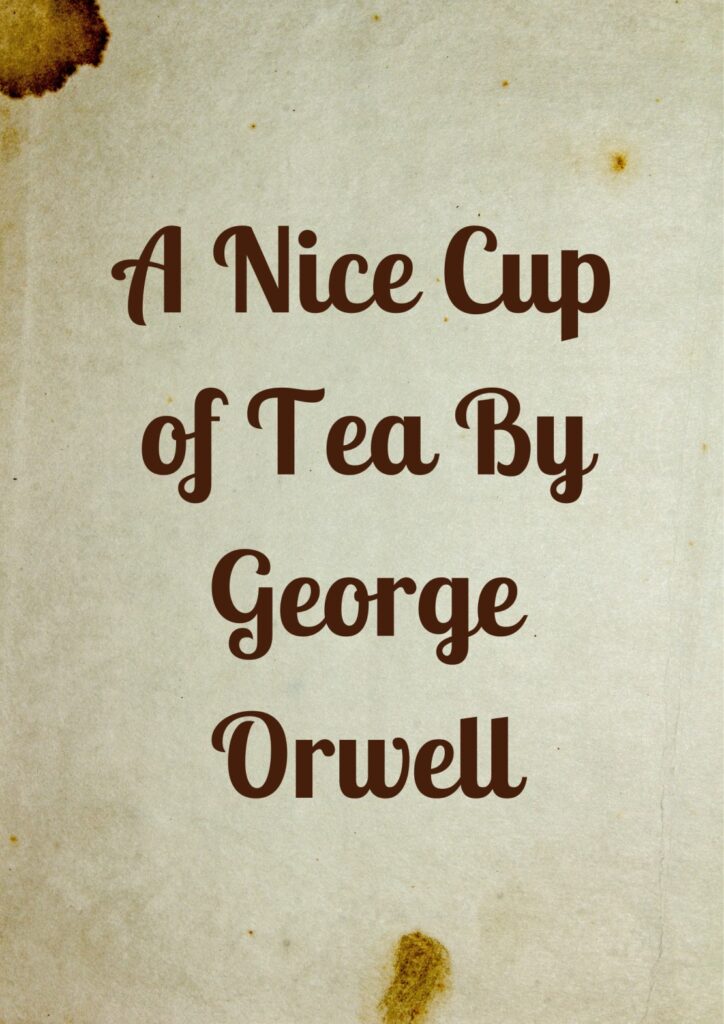Explore the insightful essay A Nice Cup of Tea by George Orwell, where he outlines his 11 golden rules for making the perfect cup of tea—blending humor, British tradition, and personal opinion into a timeless commentary.
A Nice Cup of Tea Line By Line Summary By George Orwell

BUY GEORGE ORWELL FAMOUS BOOK ON AMAZON
Summary of A Nice Cup of Tea By George Orwell
Introduction
George Orwell was not only an analyst of political and social ideologies, but he also looked at the simple but pleasant things of human life with great respect and intimacy. His essay “A Nice Cup of Tea”, published in 1946, reflects this spirit, in which he discusses in detail the “right” method of making tea.
For Orwell, tea is not just a drink, but a tradition — an experience that soothes a person’s mental state, removes the fatigue of the day and provides an emotional balance.
Essay theme: Tea, tradition and the search for perfection
Orwell makes it clear in this essay that making a “nice cup of tea” is not a trivial task. It is a matter of thought, an art and a personal choice. He says that even though every person has different ideas about the way to make tea, there are some rules that help identify the “right tea”.
In this essay, he has very intimately and firmly laid out 11 “golden rules” of tea making, which he believes to be correct based on experience, taste and logic.
Orwell’s 11 Rules – Detailed Explanation
1. Choose real tea:
Orwell believes that only tea with real leaves should be used. He calls tea bags ‘fake convenience’, which spoil the original taste of tea.
His choice: Indian or Ceylon (Sri Lankan) tea, which is thick, strong and fragrant.
2. Clay or china kettle is best suited for tea:
He believes that metal kettles can affect the taste of tea. Clay or china kettles keep the taste pure and natural.
Special: The choice of vessel is very important to maintain the aroma and warmth of tea.
3. The kettle should be preheated:
If the kettle is heated before pouring the tea, the temperature of the boiling water helps the tea leaves dissolve better and the taste deepens.
Procedure: Pour hot water, swirl the kettle and then throw away the water.
4. The tea leaves should be put directly in the kettle:
Orwell says that while making tea, a sieve or cloth should not be used because this does not allow the leaves to mix completely with the water and the taste becomes weak.
5. The water should be boiled completely:
He emphasizes that the water should be brought to a full boil, not “just hot water”. This brings out the full flavor of the tea leaves.
6. The boiling water should be poured immediately on the tea leaves:
If the water cools down, it does not cook the leaves properly. Only a fresh boil gives the tea its real taste.
7. Tea needs to be stirred:
The more evenly the combination of tea leaves and water, the better the taste. So Orwell recommends either stirring with a spoon or gently swirling the kettle two or three times.
8. Tea needs to be strong:
This is his firmest rule. He believes that a cup of tea should have enough strength to wash away your fatigue and frustration.
He believes: “Better too strong than too weak.”
9. Tea should be drunk in the right vessel:
He suggests that tea should be drunk in a wide, cylindrical, porcelain cup. In thick vessels like earthen pots, the tea cools down quickly and the taste deteriorates.
10. Add tea first, then milk:
This is a matter of debate, but in Orwell’s opinion, adding tea first allows the quantity of milk to be controlled properly. If milk is added first, the colour and depth of the tea cannot be judged correctly.
11. Adding sugar is prohibited:
According to Orwell, sugar destroys the “real taste” of tea. He says that the taste of tea is in its bitterness and intensity, not in the sweetness added to it.
His quote: “If you sweeten it, you are no longer tasting the tea, you are merely tasting the sugar.”
Social and cultural context
In Britain, tea is not just a beverage, but part of the culture. It symbolizes comfort, communication, and community.
Orwell shows in this essay that making good tea can also be a matter of personal pride.
This essay was written at a time when Britain was going through difficulties after the war. In such a situation, a good cup of tea was a feeling of comfort and normality for people.
Author’s style and point of view
This essay is written in a light, personal, but deep style, away from serious topics.
Orwell presents a simple subject in an extraordinary way. His style is interesting, analytical, and humorous.
He talks to the reader as if he were a friend sharing his experiences.
Deep message of the essay
“The true beauty of life is to find fulfillment in the little things.”
Orwell teaches through this essay that every task needs a meaning, a love, and a method — even making tea. When we start to value the little everyday experiences, life becomes richer and more joyful.
Conclusion
“A Nice Cup of Tea” is not just a recipe for making tea, but a poem about human experience — a fusion of taste, tradition, rules, and intimacy. This essay by George Orwell reminds us that true happiness lies in the simple things, when we live them deeply and attentively.